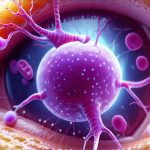The intricate connection between our minds and bodies is becoming increasingly recognized in modern healthcare. For years, gut symptoms – ranging from bloating and discomfort to more severe conditions like Irritable Bowel Syndrome (IBS) – were often addressed solely through dietary changes or pharmaceutical interventions. However, a growing body of research suggests that factors seemingly unrelated to digestion, such as music and light exposure, can significantly influence our gut health and the experience of gastrointestinal distress. This isn’t about replacing conventional treatments; it’s about understanding the holistic nature of well-being and exploring potential complementary approaches that address the complex interplay between psychological state, nervous system function, and the microbiome within our digestive system.
The gut is often referred to as our “second brain” due to its extensive neural network – the enteric nervous system – which communicates directly with the central nervous system (our brain). This bidirectional communication pathway, known as the gut-brain axis, explains why stress and anxiety can manifest physically as digestive issues, and conversely, why a healthy gut microbiome is linked to improved mental health. Exploring how external stimuli like music and light impact this crucial axis opens up exciting possibilities for managing gut symptoms and improving overall quality of life. This article delves into the burgeoning science behind these connections, looking at current research and potential applications – all while emphasizing that further investigation is needed to fully understand these fascinating relationships.
The Influence of Music on Gut Function
Music’s power to evoke emotions is undeniable. We intuitively understand its ability to calm, energize, or even distress us. But the impact goes beyond psychological effects; studies are beginning to reveal how music can directly influence physiological processes within our gut. This isn’t simply about feeling relaxed while listening to a soothing melody – it’s about measurable changes in digestive function and microbiome activity. Researchers are investigating whether specific frequencies, rhythms, and even genres of music have different effects on the gastrointestinal system.
The connection likely stems from several mechanisms. Music can modulate the autonomic nervous system, specifically influencing the balance between sympathetic (fight-or-flight) and parasympathetic (rest-and-digest) activity. When we listen to calming music, it tends to activate the parasympathetic nervous system, promoting relaxation and digestive processes. Conversely, stressful or jarring music may trigger a sympathetic response, potentially inhibiting digestion and exacerbating gut symptoms. Moreover, sound vibrations themselves might directly impact the gut microbiome, influencing its composition and function. Some research suggests that certain frequencies can stimulate beneficial bacteria growth while suppressing harmful ones. Understanding if [artificial sweeteners affect gut health] could also provide insight into dietary influences on these processes.
Consider these potential avenues for exploration:
– Music therapy specifically tailored to individuals with IBS or other functional gastrointestinal disorders could incorporate personalized playlists designed to promote relaxation and reduce stress.
– Investigating the impact of different musical genres on gut motility (the movement of food through the digestive tract) – slower, more melodic music might be beneficial for those experiencing diarrhea, while faster-paced music could help alleviate constipation in some individuals.
– Studying how music affects the production of gut hormones that regulate appetite and digestion. If [intolerances be temporary or permanent] impacts dietary choices, it’s worth considering when creating personalized playlists.
The Role of Light Exposure and Circadian Rhythm
Our bodies are intrinsically linked to the natural light-dark cycle – our circadian rhythm. This internal clock regulates not only sleep-wake cycles but also a vast array of physiological processes, including digestion. Disruptions to this rhythm, often caused by irregular light exposure or shift work, have been increasingly linked to gut dysbiosis (an imbalance in the gut microbiome) and increased susceptibility to gastrointestinal disorders. The impact isn’t merely about timing; the quality of light also plays a crucial role.
Artificial lighting, especially blue light emitted from screens, can suppress melatonin production – a hormone essential for regulating sleep and gut health. Chronic disruption of melatonin levels can lead to inflammation in the gut, altered gut permeability (“leaky gut”), and changes in microbiome composition. Conversely, exposure to natural sunlight, particularly in the morning, helps synchronize the circadian rhythm, promoting healthy digestive function and reducing the risk of gut-related symptoms. This synchronization impacts everything from stomach acid production to intestinal motility. It’s also important to consider if [can menstrual cycles affect reactions to food] impact these processes.
The interplay between light, circadian rhythms, and gut health is complex, but some key points emerge:
1. Prioritizing exposure to natural sunlight, especially early in the day, can help regulate the circadian rhythm and improve digestive function.
2. Minimizing blue light exposure from screens in the evening can protect melatonin production and reduce inflammation in the gut.
3. Consider using light therapy devices that mimic natural sunlight during periods of limited outdoor access, particularly during winter months.
The Impact on the Gut-Brain Axis: A Deeper Dive
The gut-brain axis is a two-way street. Signals travel from the brain to the gut influencing digestion and motility, but also from the gut to the brain affecting mood, cognition, and even behavior. Music and light both impact this communication pathway. For example, soothing music can reduce cortisol levels (the stress hormone), leading to decreased inflammation in the gut and improved microbial balance. This, in turn, sends positive signals back to the brain promoting a sense of calm and well-being. Similarly, regulating circadian rhythm through proper light exposure helps stabilize gut hormones like ghrelin and leptin which influence appetite and satiety, impacting both physical and mental states.
The vagus nerve is a key component of this axis – it’s the longest cranial nerve in the body connecting the brain to many major organs including the gut. Stimulation of the vagus nerve through practices like meditation or deep breathing exercises (often enhanced by calming music) can improve gut function, reduce inflammation and even alleviate anxiety. Light exposure, particularly sunlight, also influences vagal tone – a measure of the vagus nerve’s activity – potentially promoting a more balanced and resilient nervous system. This highlights how seemingly disparate factors converge to influence our overall health. Understanding [gut sensitivities cause panic attacks] can help clarify this connection.
Music Therapy Applications for Gut Health
While research is still emerging, preliminary studies suggest that music therapy could be a valuable complementary approach for managing gut symptoms. The key lies in personalized interventions – recognizing that different individuals respond to different types of music. A therapist might assess a patient’s musical preferences and emotional responses to create a tailored playlist designed to promote relaxation, reduce stress, and improve mood. This is not simply about selecting “calming” music; it’s about understanding the individual’s unique relationship with sound.
Specific applications include:
– Using music during colonoscopies or other invasive procedures to reduce anxiety and discomfort.
– Incorporating music therapy into IBS management programs to help patients cope with stress and improve gut function.
– Developing personalized music playlists for individuals experiencing chronic abdominal pain or bloating, focusing on sounds that promote relaxation and distraction from discomfort.
It’s important to note that music therapy should not be seen as a replacement for conventional medical treatments but rather as an adjunct therapy to enhance overall well-being. A qualified music therapist can provide guidance and support in developing a safe and effective intervention plan. If [gut healing reverse food sensitivities] is part of the treatment, it’s important to integrate this into musical choices.
Optimizing Light Exposure for Gut Wellness
Beyond simply getting more sunlight, optimizing light exposure requires understanding the nuances of circadian rhythm regulation. The timing of light exposure is crucial – morning sunlight is particularly important for synchronizing the internal clock. Aim to get at least 20-30 minutes of natural light early in the day, preferably within an hour of waking up. This helps establish a strong circadian signal and sets the stage for healthy digestive function throughout the day.
Minimizing blue light exposure in the evening is equally important. Consider these strategies:
1. Using blue light filters on electronic devices or wearing blue-light blocking glasses.
2. Dimming lights in the evening and creating a relaxing bedtime routine that promotes sleep.
3. Avoiding screen time at least an hour before bed.
For individuals who work indoors or live in areas with limited sunlight, light therapy lamps can provide a valuable substitute. These devices emit bright, full-spectrum light that mimics natural sunlight and can help regulate the circadian rhythm. However, it’s essential to use these lamps according to manufacturer instructions and consult with a healthcare professional if you have any underlying health conditions. If [can caffeine worsen gut inflammation] is a concern, integrating this into lifestyle choices along with light optimization will be beneficial.


















